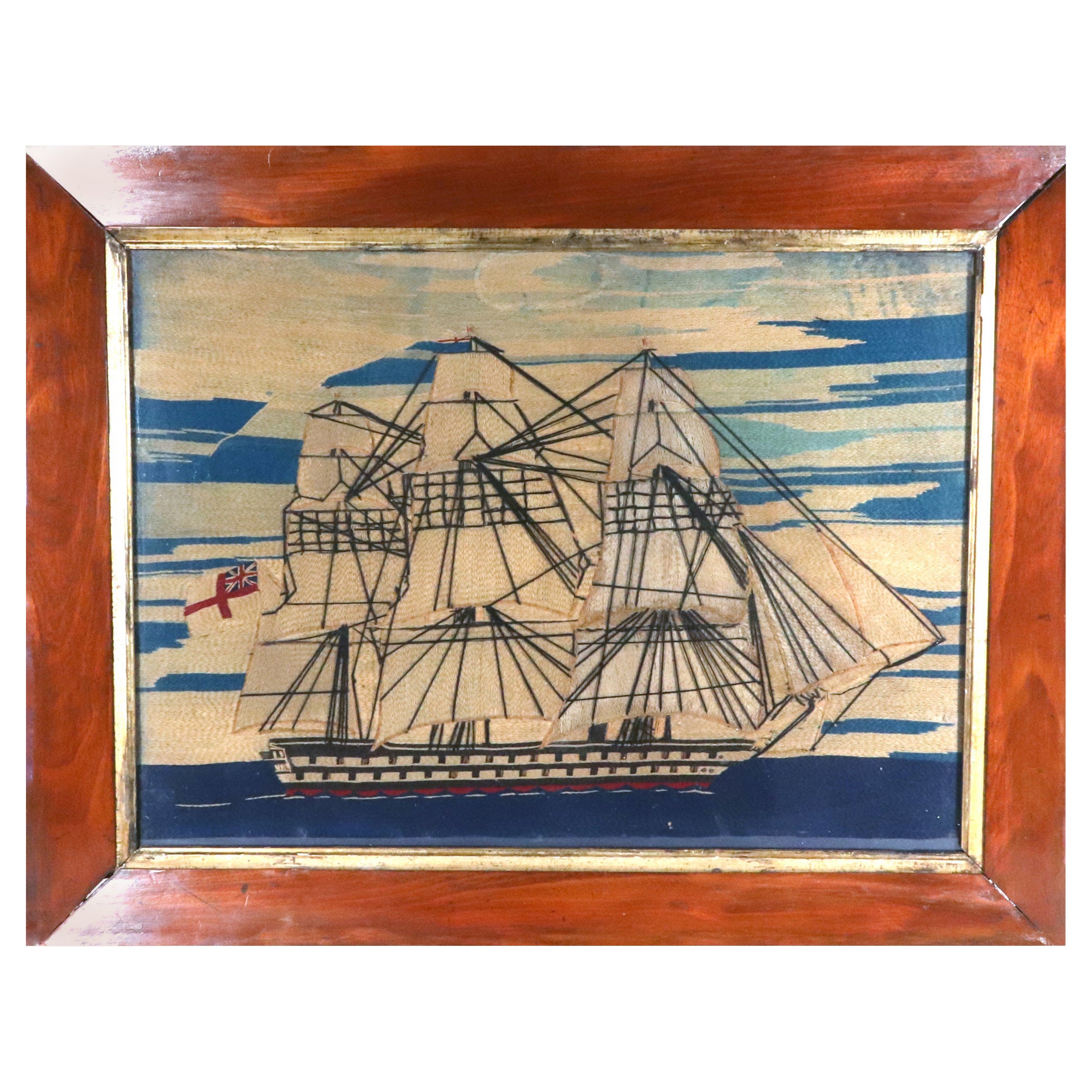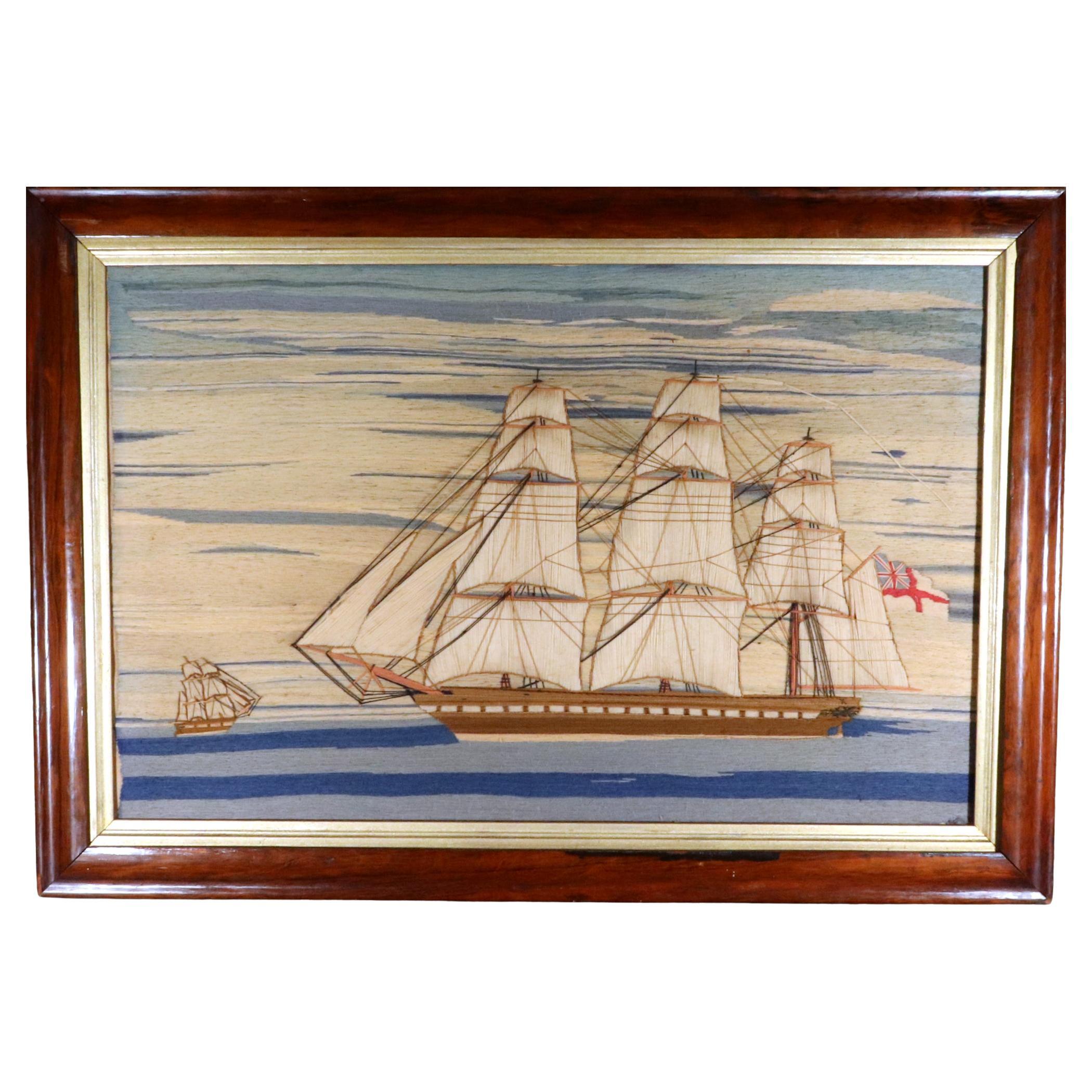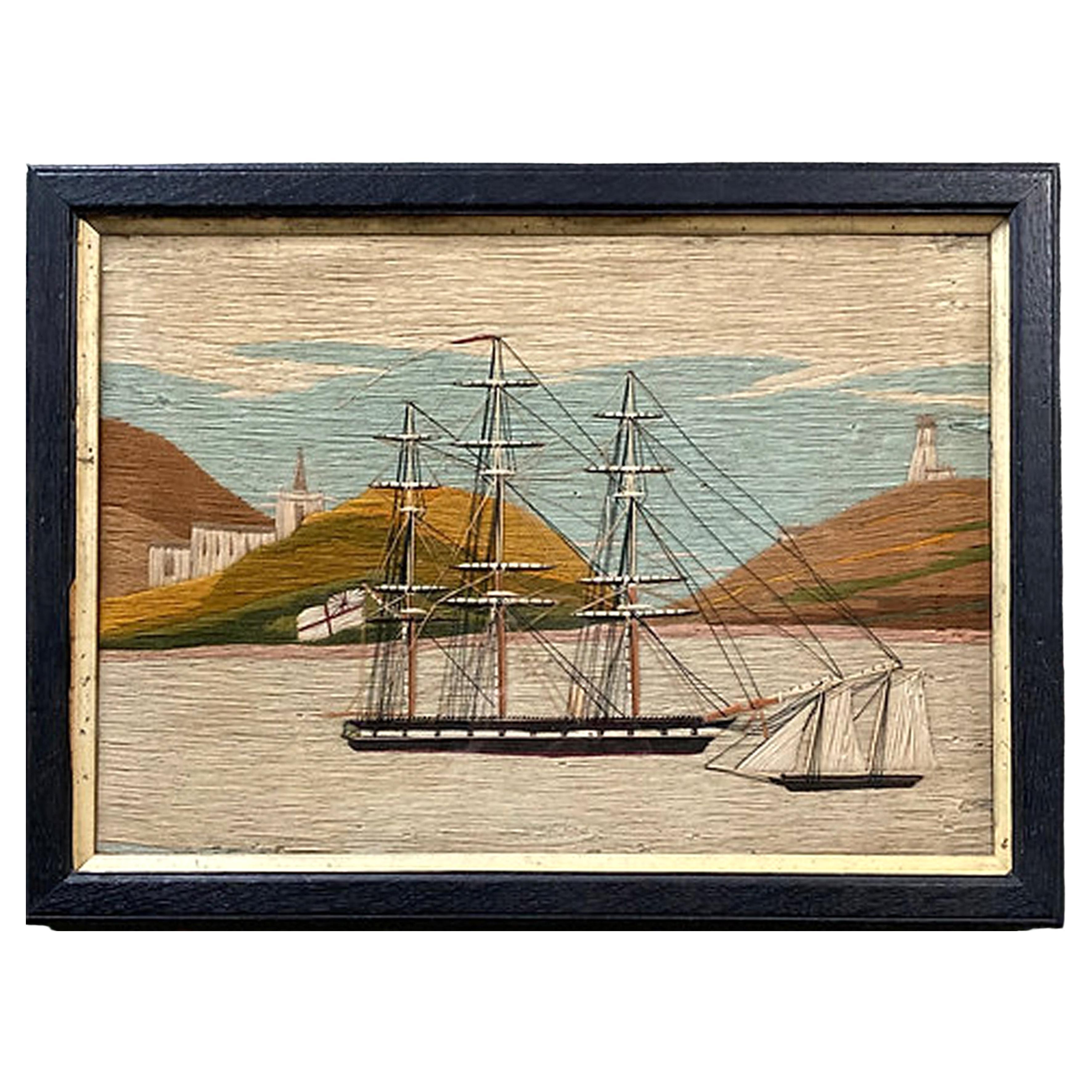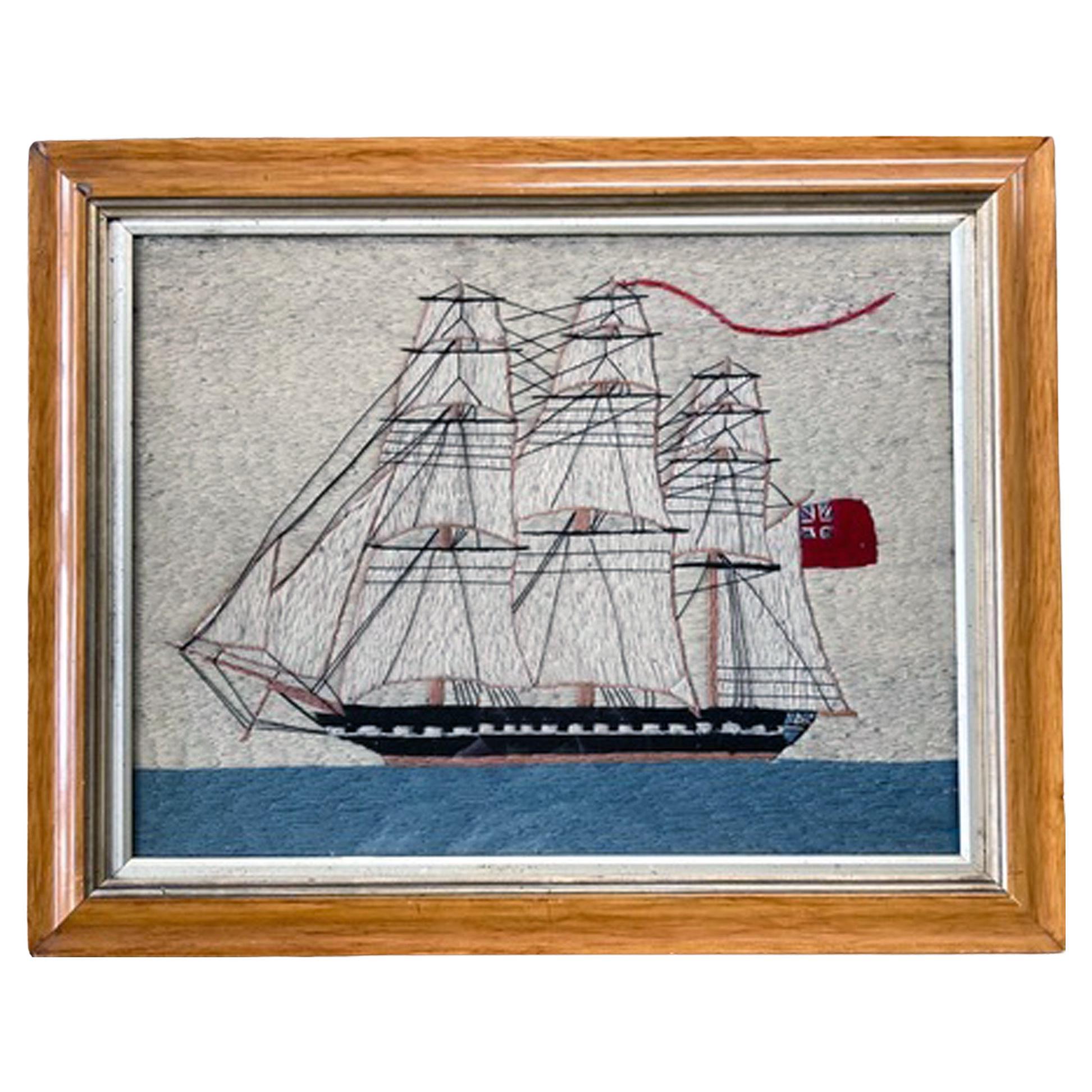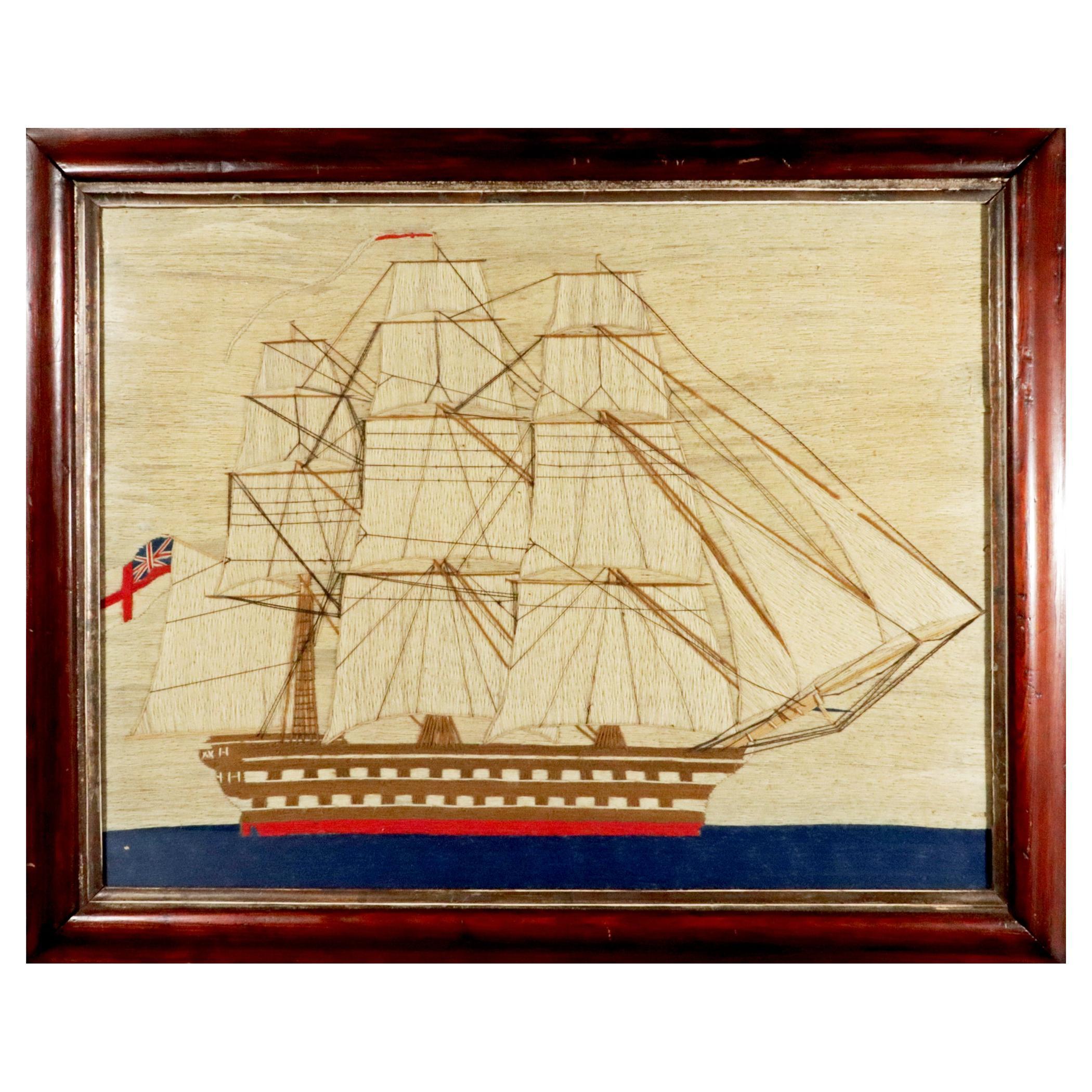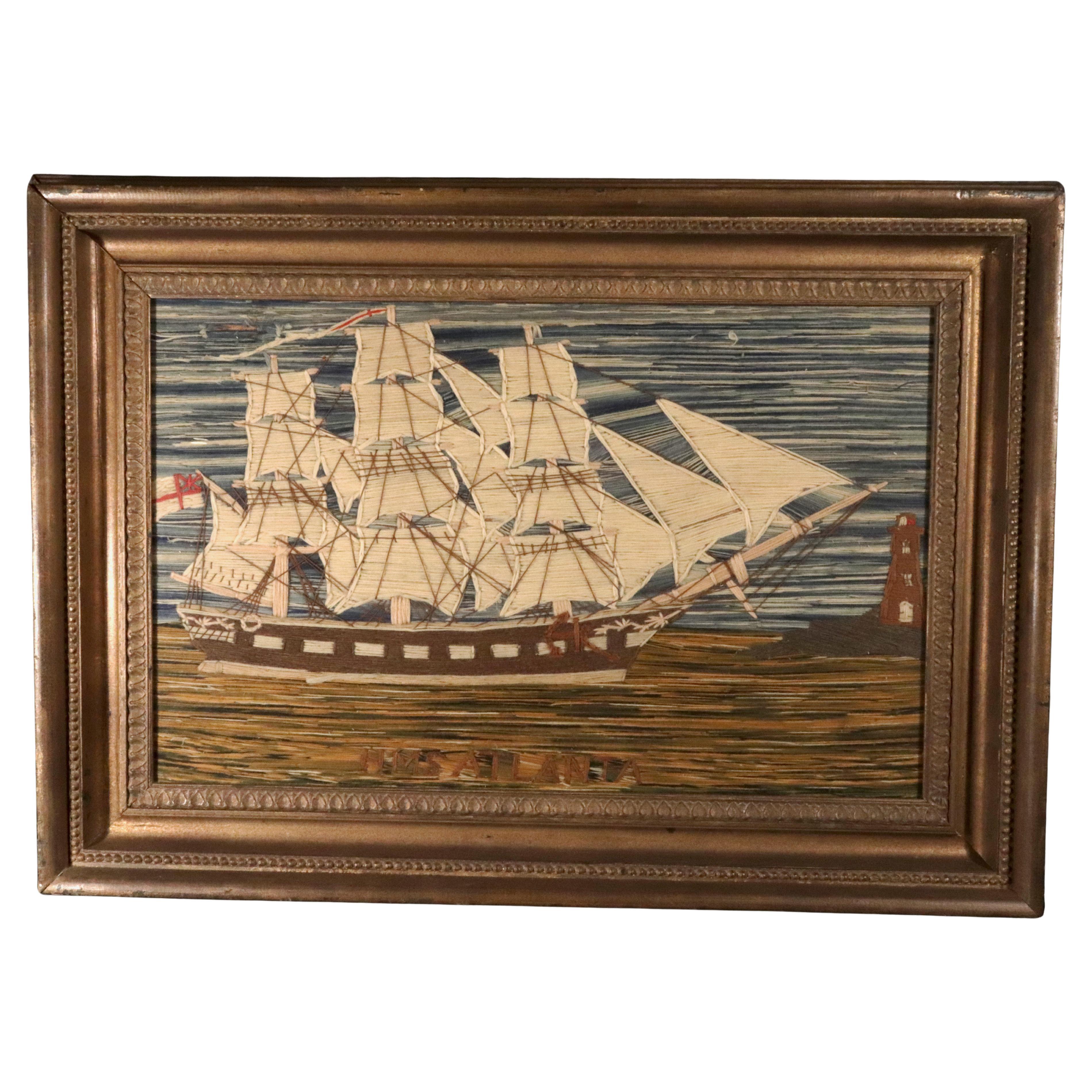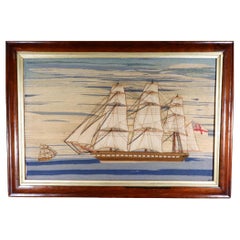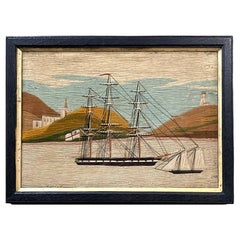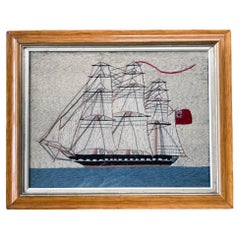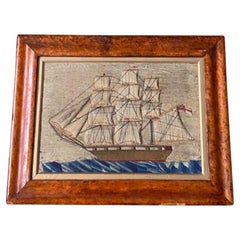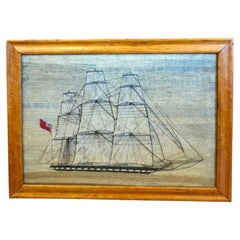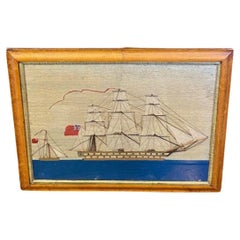Items Similar to British Sailor's Woolwork of a Tea Clipper
Want more images or videos?
Request additional images or videos from the seller
1 of 12
British Sailor's Woolwork of a Tea Clipper
$7,000
£5,332.84
€6,086.03
CA$9,836.66
A$10,720.22
CHF 5,676.82
MX$128,761.19
NOK 71,869.81
SEK 66,077.22
DKK 45,455.89
About the Item
British Sailor's Woolwork of a Tea Clipper,
Circa 1875
The large sailor's woolwork or woolie as they are also called depicts a port side view of a tea clipper ship. The three masted ship is under full sail out to sea. The ship mostly fills the space within the maple frame. The sea is distinctively depicted with splashes of wavy hues of blue both light and dark against a cloudy sky.
The wool is made with a early and rare chain-stitch.
Dimensions: 22 inches high 29 3/4 inches wide.
Now elegantly presented, this maritime artwork is housed in a beautiful maple frame featuring a classic ogee-form. The frame is fitted with museum glass, chosen specifically for its ability to significantly reduce reflections while offering substantial UV protection, safeguarding this piece for years to come.
Reference:
Shipbuilding underwent a revolution in the 19th century, resulting in the development of clipper ships, a pinnacle of nautical engineering and design. The term "clipper" referred to their ability to "clip" or cut down passage times, a testament to their speed and efficiency. These vessels, characterized by their long, narrow hulls, sharp bows, and an exceptionally large sail area, were designed for maximum velocity, often at the expense of cargo capacity.
Origins and Evolution
The genesis of clipper ships can be traced to the Baltimore "clippers" of the late 18th and early 19th centuries, smaller, fast schooners used for privateering and smuggling. However, the true "clipper era" dawned in the 1840s, driven by a confluence of economic factors and technological advancements. The burgeoning trade routes, particularly the China tea trade and the California Gold Rush, created an immense demand for rapid transport of high-value goods and passengers.
Key innovations in naval architecture, including refined hull lines based on scientific principles of hydrodynamics and improved sail plans, allowed for the unprecedented speeds these ships achieved. American shipyards, notably those in Boston, New York, and Baltimore, became epicenters of clipper construction, with designers like Donald McKay achieving legendary status for their groundbreaking designs.
Design and Characteristics
The defining features of a clipper ship were:
Sleek Hull: A long, slender hull with a concave or "hollow" bow and a sharp, often raked, stern. This design minimized wetted surface area and reduced resistance through the water.
Extreme Sheer: The upward curve of the deck towards the bow and stern, contributing to their graceful appearance and aiding in shedding water during rough seas.
Massive Sail Area: Clippers carried an enormous amount of canvas across multiple masts (typically three, occasionally four). Square-rigged on all masts, they boasted an intricate arrangement of sails, including skysails, moonrakers, and even studding sails, to harness every available breath of wind. This extensive rigging required large, skilled crews to manage.
Lightweight Construction: While robust, efforts were made to reduce overall weight, often utilizing lighter woods and less robust framing where structural integrity permitted, further contributing to speed.
Operational Significance
Clipper ships fundamentally altered global trade dynamics. Their unparalleled speed dramatically reduced transit times, making perishable goods like tea more accessible and facilitating faster communication. For instance, voyages from New York to San Francisco, which could take over 150 days for traditional vessels, were routinely completed by clippers in 90 days or less, with record runs under 80 days. This speed translated directly into increased profits for merchants.
The competitive nature of the tea races from China to London or New York, where the first ship to arrive with the new season's tea commanded the highest prices, further fueled the drive for faster and more efficient clipper designs. These races captivated the public imagination and pushed the boundaries of shipbuilding.
Decline of the Clipper Era
Despite their technological prowess and romantic appeal, the reign of the clipper ship was relatively short-lived, largely due to the advent of new technologies. The opening of the Suez Canal in 1869 significantly shortened the route to Asia, favoring steamships which, while slower, were not reliant on wind and could maintain a more consistent schedule. Furthermore, advancements in steam engine technology led to more fuel-efficient and powerful steamships that could carry vastly more cargo. The economic advantage shifted decisively towards steam, and by the 1870s, the golden age of sail, epitomized by the clipper, began its irreversible decline.
(Ref: VM98756)
- Dimensions:Height: 22 in (55.88 cm)Width: 29.75 in (75.57 cm)Depth: 1 in (2.54 cm)
- Style:Folk Art (Of the Period)
- Materials and Techniques:
- Place of Origin:
- Period:
- Date of Manufacture:1870
- Condition:Wear consistent with age and use. Now elegantly presented, this maritime artwork is housed in a beautiful maple frame featuring a classic ogee-form. The frame is fitted with museum glass, chosen specifically for its ability to significantly reduce reflections.
- Seller Location:Downingtown, PA
- Reference Number:Seller: VM987561stDibs: LU861046069422
About the Seller
5.0
Recognized Seller
These prestigious sellers are industry leaders and represent the highest echelon for item quality and design.
Gold Seller
Premium sellers maintaining a 4.3+ rating and 24-hour response times
Established in 1916
1stDibs seller since 2009
432 sales on 1stDibs
Typical response time: 1 hour
Associations
The Art and Antique Dealers League of AmericaAntiques Associations Members
- ShippingRetrieving quote...Shipping from: Downingtown, PA
- Return Policy
More From This Seller
View AllBritish Sailor's Woolwork of Royal Navy Ship
Located in Downingtown, PA
British Sailor's Woolwork of Royal Navy Ship,
The sailor's woolwork or woolie depicts a starboard view of a Second-Rate Royal Navy Ship with three masts. T...
Category
Antique 1870s English Folk Art Nautical Objects
Materials
Wool
British Sailor's Woolwork of a Royal Navy White Fleet Frigate
Located in Downingtown, PA
British Sailor's Woolwork of a Royal Navy White Fleet Frigate
The sailor's woolwork depicts a portside view of a square-rigged three masted ship flying the White Ensign. The blue s...
Category
Antique 1870s English Folk Art Nautical Objects
Materials
Wool
British Sailor's Woolwork of Royal Navy Ships in a Bay
Located in Downingtown, PA
British Sailor's Woolwork of Royal Navy Ships in a Bay,
Circa 1860-75
This charming sailor's woolwork, commonly referred to as a "woolie," presents a Royal Navy frigate at anchor in...
Category
Antique Mid-19th Century English Folk Art Nautical Objects
Materials
Wool
British Sailor's Woolwork of Merchant Ship Under Full Sail
Located in Downingtown, PA
British Sailor's Woolwork of Merchant Ship Under Full Sail,
Circa 1875
The British sailor's woolie depicts a port side view of a large three-masted ship flying the Red Ensign on a f...
Category
Antique 1870s Folk Art Nautical Objects
Materials
Wool
British Sailor's Woolwork of a Royal Navy Second Rate Battleship
Located in Downingtown, PA
British Sailor's Woolwork of a Royal Navy Second Rate Battleship,
Circa 1875
The charming simple sailor's woolie depicts a starboard side view of a Royal Navy second rate battleship...
Category
Antique 1870s English Folk Art Nautical Objects
Materials
Wool
British Sailor's Woolwork of Named HMS Atalanta Coming into Port
Located in Downingtown, PA
Large and Historically Significant Sailor's Woolwork of HMS Atalanta,
British,
Circa 1880.
This large and impressive sailor's woolwork, or "woolie," is a richly colored and wonderf...
Category
Antique Late 19th Century English Folk Art Nautical Objects
Materials
Wool
You May Also Like
Sailor's Folk Art Woolie of a Single Decker Ship of the Line, circa 1850
Located in Nantucket, MA
Antique Sailor's Folk Art Woolie of a Single Decker Ship of the Line, circa 1850, a sailor's folk art woolwork picture handcrafted of woolen yarn in a bold variety of stitches, depic...
Category
Antique Mid-19th Century English Folk Art Nautical Objects
Materials
Wool
19th Century sailor's Woolie of a British Frigate, circa 1870
Located in Nantucket, MA
19th Century Sailor's Woolie of a British Frigate, circa 1870 , a British sailor's hand-crafted woolwork picture with a large starboard side view of a frigate with single gun deck, u...
Category
Antique 1870s English Folk Art Nautical Objects
Materials
Wool
19th Century sailor's Woolie of a British Steam Frigate, circa 1850
Located in Nantucket, MA
19th Century Sailor's Woolie of a British Steam Frigate, circa 1850, a hand crafted sailor's woolwork picture with larboard side view of a British Naval Auxiliary Steam Frigate unde...
Category
Antique 1850s English Folk Art Nautical Objects
Materials
Wool
19th Century Sailor's Folk Art Woolie with Ship of the Line and Sloop, ca 1850
Located in Nantucket, MA
19th Century Sailor's Folk Art Woolie with Triple Decker Ship of the Line and Sloop, ca 1850, depicting a starboard side view of a majestic square-rigged...
Category
Antique Mid-19th Century English Folk Art Nautical Objects
Materials
Wool
19th Century Sailor's Woolie of the Ship JANE Under Full Sail
Located in Nantucket, MA
Early to Mid 19th Century Sailor's Woolie of the Merchant Ship JANE Under Full Sail, circa 1840s, a hand-crafted sailor's woolwork picture depicting a larboard side view of fully rig...
Category
Antique 1840s English Folk Art Nautical Objects
Materials
Wool, Cotton
Antique Woolie Sailor's Woolwork Embroidery of a Ship
Located in Chelmsford, Essex
Antique Sailor's Woolwork Embroidery Picture of a three masted ship. The embroidery is worked in wool and cotton in a variety of stitches, on cotton ground. Some details picked out i...
Category
Antique 1870s Tapestries
Materials
Wool
